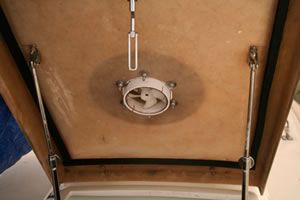I’ve been growing several interesting varieties of mold and mildew at home. It is glamorous work, I know. While my wife, Theresa, disagrees, I know that you understand.
This Practical Sailor project led me to our last test of mildew cleaners, and some helpful tips for keeping mildew at bay.
Having been closely involved in our mildew cleaner test and the upcoming report on spray-on mildew shields that supposedly prevent mildew growth, I’m convinced that sprays can help fight mold, but these shouldn’t be your first weapon against it.
The best way to fight mildew onboard is to keep it from ever starting in the first place. Prevention is your best defense. When storing your boat or leaving it closed up for an extended time, a few simple steps will help prevent mildew.
Clean and dry everything. Use a diluted water-bleach mixture on surfaces not likely to be damaged by the bleach. Wipe down and dry the head, shower, sinks, and the galley counters. Do the same for the overhead and walls/bulkheads.
Leave open all drawers, doors, and lockers to promote circulation. If covering the boat with a tarp, create ventilation between the tarp and the hull by hanging a few fenders between them. Prop up mattresses and cushions, or just remove them along with life jackets and foul-weather gear-even fenders and lines. Anything paper-charts, books, paper towels, etc.-should be stowed in air-tight bags or removed.
Good air circulation and moisture control go a long way toward keeping mildew at bay. Keeping the relative humidity below 55 percent throughout the boat gives you a good chance of preventing mold growth. Relative humidity can be measured by a hygrometer, available at many marine and air-conditioner stores, as well as some mega-retailers or hardware stores.
At the dock, a home dehumidifier, a dehumidifying stick (like the Golden Rod, effectively a small heater), or even a light bulb positioned under a vent can help promote air circulation and moisture removal. Moisture-absorption packets like silica gel can also help. These porous granules absorb up to half their weight in moisture from the atmosphere and can be purchased inexpensively in bulk at hardware stores.
The AbsorBag by Buffers USA uses calcium chloride to absorb moisture. The company also sells a non-toxic desiccan’t bag, E-Sorb, that uses montmorillonite clay for absorption. Star brite makes similar products, like the No Damp dehumidifier. PS plans to test these and other moisture absorbers in the future.
Ventilation products
Mildew thrives in humid, damp spaces, so keeping your cabin and lockers well ventilated is key. PS has tested numerous ventilation products and published a handful of articles on the subject.
Were big fans of cowl vents coupled with Dorade boxes (PS May 15, 1997) to let air in but keep water out. A Dorade box is simply a water trap that employs a down-draft pipe offset laterally from the throat of the cowl vent. Vetus supplies a wide range of well-made cowl ventilators.
Twelve-volt fans (PS April 2008) and solar-powered vents (PS May 1, 1993) also keep fresh air flowing in the cabin. The Hella Turbo fan outlasted three other popular models in PSs 2000 cabin fan longevity test. It also was among the recommended fans in our 2008 test.
Nicro Day and Night solar-powered vents from Marinco are another option. The vent pictured above was installed on the lazarette of a Cape Dory 25, as part of a restoration project documented in the March issue. During the day, the solar panel charges a small Nicad battery to power the fan at night. In effect, you get 24-hour operation and continuous circulation.
Sails
Proper sail care and maintenance go a long way toward keeping those unsightly black blotches off your canvas. We culled the following tips from sail care experts and authors Dan Neri (Sail Care and Repair), William Burr (Boat Maintenance), and Roger McAfee (The Warm Dry Boat, the Seattle sailors bible).
Never stow sails when they are damp or salty as salt attracts moisture. (Fresh-water rinse salty sails.) Air them out regularly, especially after a rain.
Keep mildew-infected sails away from clean ones, and try to clean infected sails as quickly as possible. Stains are easier to treat when they are new.
Never use bleach on Kevlar or nylon as it will destroy the fibers. Washing these or Dacron sails in a chlorine-treated swimming pool will turn them brittle and yellow. To clean Dacron sails, first try lemon juice and water to spot clean and let them dry in the sun. For stubborn stains, try diluted Tilex, but be sure to rinse it off thoroughly to avoid longterm damage from the residue. To clean Kevlar, use only water. Lysol can be used as an effective fungicide.
Laminates grow fungus more readily than woven polyester because the film is impermeable and moisture cannot escape.
Now, to see how that shower mold is growing . . .

































